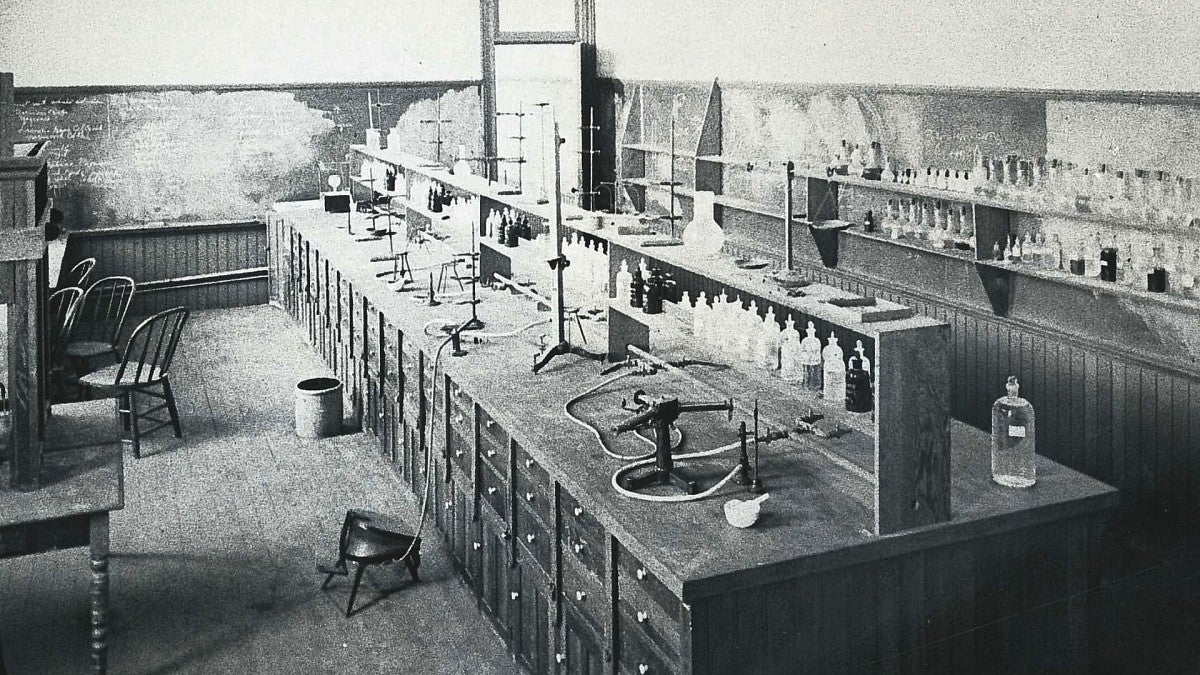
Natural philosophy (a term comprising both physics and chemistry that was commonly used in the 19th century) was part of the curriculum at the University of Oregon from the year it was founded in 1876. In 1879, approximately $2,000 were spent to purchase equipment for a physics laboratory, an unusually large sum at the time.
Initially, physics was taught by Mark Bailey, professor of mathematics, but in 1879 the university appointed George H. Collier to the Chair of Physics, Chemistry, and Metallurgy. He hired E.H. McAllister and S.E. McClure, the latter of whom became professor of chemistry when the subjects of physics and chemistry were divided, while Collier remained professor of physics until 1895.
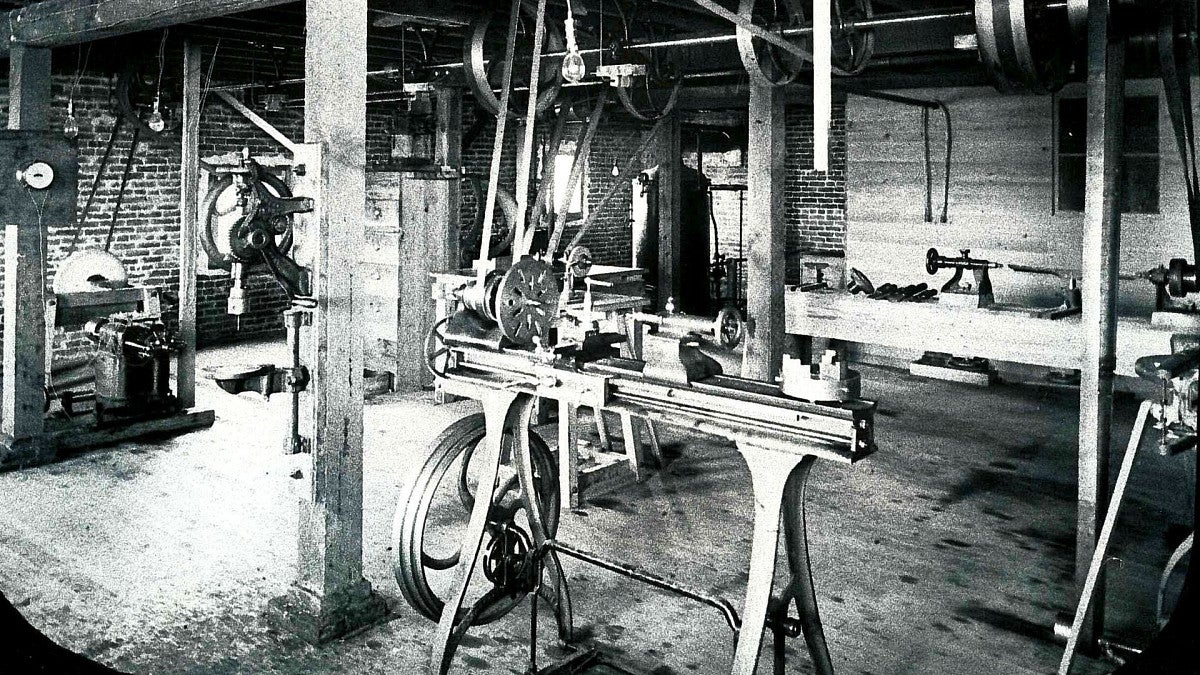
Under his successor, Charles Fridel, the department started to expand. In 1904, William P. Boynton, assistant professor of physics, published a book on kinetic theory, which then was a very advanced topic. By 1920 the department had three faculty members. After a tumultuous time during the Great Depression, when for a while the very existence of the University of Oregon was threatened, the department has continued to expand. After World War II, research at the forefront of scientific development was increasingly implemented at the University of Oregon.

Above is a group photo taken in 1960. Gradually, the department grew to its present size of about 30 faculty members who are engaged in research in most of the active subfields of Physics.
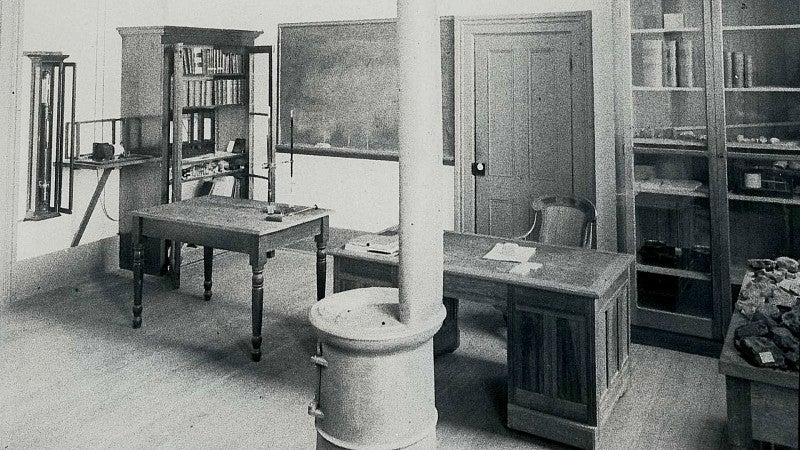

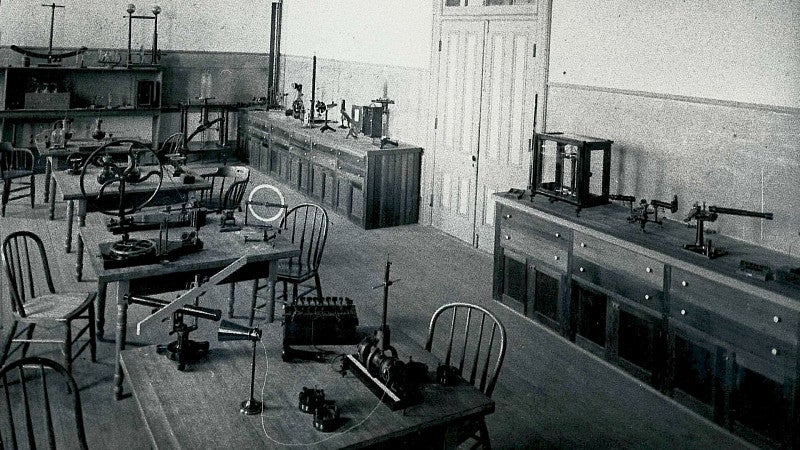
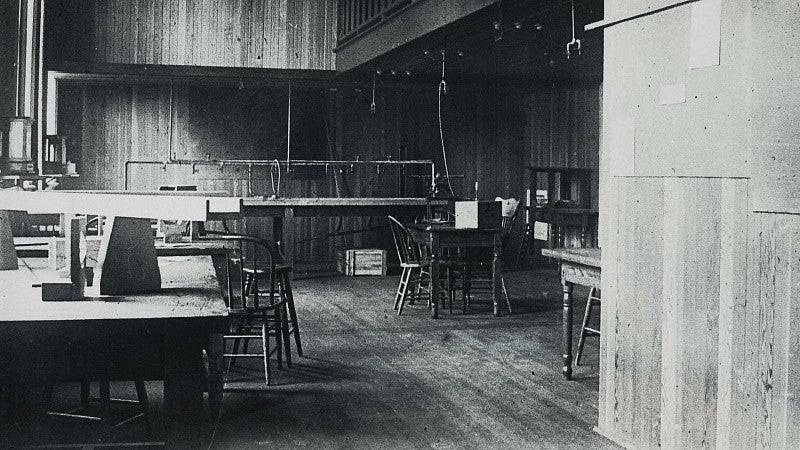
Skinner Butte Astronomical Observatory
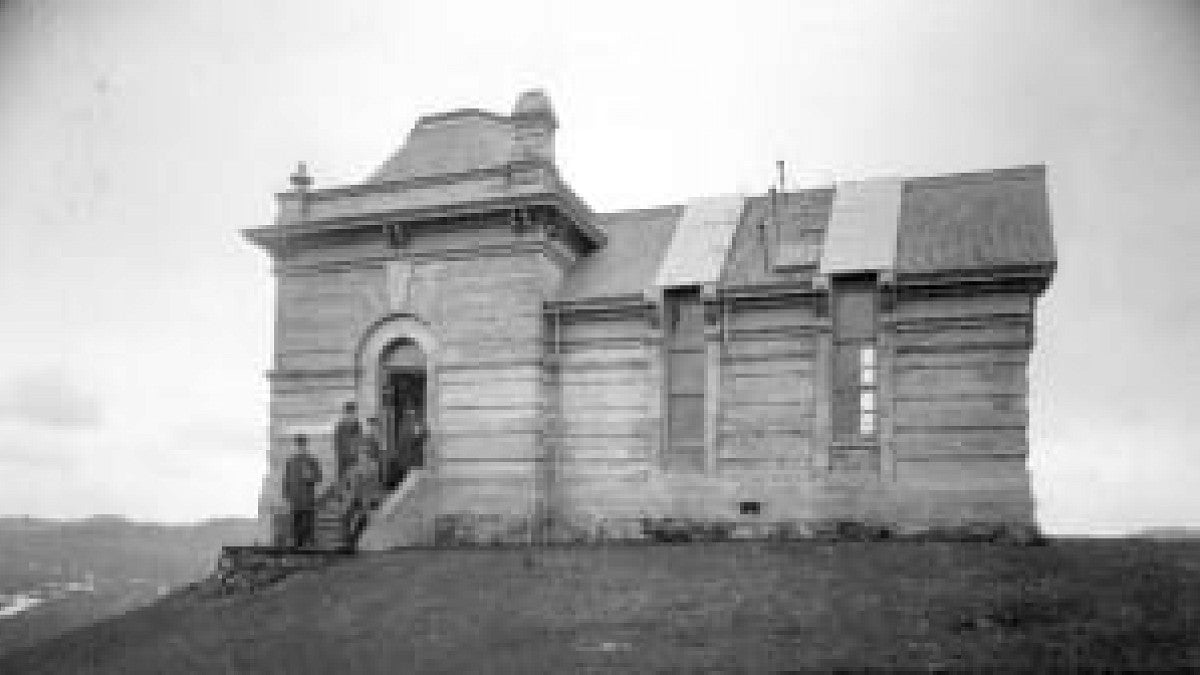
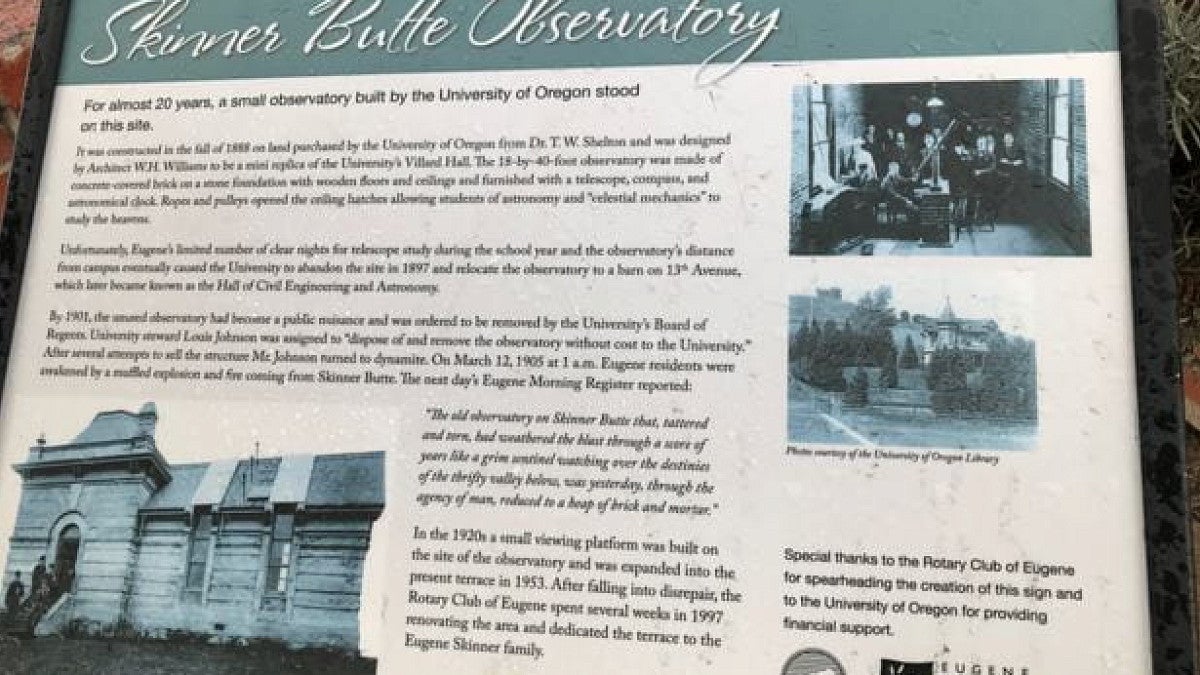
The University of Oregon has a long-standing history of astronomy and established its very own observatory at the top of Skinner’s Butte in Eugene during the late 1800s. You may find the original site markings located at the summit of Skinner’s Butte which is easily accessible by car, or by a short hike up the wooded hill at the North end of Eugene. Skinner’s Butte was originally called Ya-Po-Ah by the Kalapuya natives of the area.
In 1876, the University of Oregon’s first building was completed. Known as the “Old Building,” and later officially named Deady Hall (now ‘University Hall’), it would remain as the only university structure for a decade. Then, in 1886, construction of the university’s second building, Villard Hall, was completed.
Many people know of the campus’s first two buildings; they stand out architecturally and are both on the national register of historic places. Fewer people, however, are aware of the university’s third building ever constructed.
Back in 1878, the university was only about two years old. Even then, the board of regents wanted to establish a school of astronomy and celestial mechanics. For 10 years they mulled over where to put this new department and where to house an observatory, which would be necessary for classroom teaching.
Judge Joshua J Walton, a prominent Eugene citizen and secretary of the board of regents, was heading back east for a summer vacation to Philadelphia. The university gave him $4000 to purchase equipment for the future observatory.
While in Philadelphia, Walton acquired a $900 state-of-the-art telescope through a local firm. He also purchased, through a separate Pennsylvania company, a solar compass and a sidereal clock. He returned to the university to receive the equipment, which he had shipped via train. The telescope and other equipment ultimately sat in storage while the university continued to argue for years over the location of its future observatory.
Some reasoned that Deady Hall should be extended; one regent suggested an observatory be installed in one of the building’s spires. Others wanted an entirely separate building constructed for the observatory but couldn’t agree on where to purchase land for it.
During the almost 10 years of bickering over the observatory, Villard Hall was planned and erected as the school’s second building.
In 1887, Dr. T. W. Shelton, owner of Skinner Butte and surrounding lands at the time, was nearly finished with the construction of his “Castle on the Hill,” a Queen Anne-style mansion like no other, perched on the terraced southern slope halfway up the butte and overlooking the entire city.
The university had already attempted at one point to solicit Shelton to purchase a spot on his butte for the observatory, and Shelton adamantly declined. He was not going to have an eyesore of a building ruin his otherwise pristine butte. However, right as the Shelton mansion was almost near its completion, the structure was completely engulfed and destroyed by a fire late one night. Decades later, on his death bed, an aggrieved former workman of Shelton’s admitted to setting the fire over a dispute in payment for work done.
A year later in 1888, Shelton, motivated to rebuild his dream home quickly and running low on funds, finally gave in and agreed to sell a small plot at the top of the butte to the University.
Shelton sold the school a 100-foot-by-1,800-foot tract of land for $1,000.
In November of 1888, the University of Oregon’s Skinner Butte Observatory was completed atop the hill. The observatory, the official third building of the state school, was built as a tiny 18-by-40-foot miniature version of Villard Hall by prominent local architect W. H. Abrams for the amount of $4,782.78.
The telescope, solar compass, and sidereal clock were finally brought from storage, dusted off, and installed inside the new structure, along with classroom fittings and a sundial. The $900 telescope was elaborately mounted on a dressed stone, on top of a brick pier within the center of the observatory. The roof was retractable via a rope-and-pulley system for viewing the night sky.
At first the observatory was a proud success. Students were eager to enroll in the first official classes held at the butte during winter term of 1889.
Problems quickly came to light, however, as the academic school year was the worst time for viewing anything in Oregon’s night sky. The majority of nights were overcast, foggy, or simply poured rain. The only reasonable times for the observatory’s use were during the summer months, when students were out of school, working the farms and helping with family businesses. Furthermore, it began to prove problematic to require students to trek to the top of Skinner Butte, a 600-foot summit located two miles from the main campus of Deady and Villard Hall, quite some distance at a time before modern transportation.
The university began looking elsewhere for a closer, on-campus location for an observatory. In 1890, the school bought the Collier House, built in 1886 for Professor Collier, located across 13th Avenue from campus, between Johnson Hall and the EMU.
The Collier House, at the time, had a barn on the property, which was renovated into classrooms and a second observatory known as a “Barn Hall.” This building would have been where Hendricks Hall now stands. Barn Hall turned the Skinner Butte observatory obsolete overnight, and the building on the hill was essentially disregarded, falling into disrepair atop the cold, treeless, windswept butte.
By 1897, even prior to being fully abandoned, the Skinner Butte Observatory had been broken into and vandalized repeatedly. In June of that year, the telescope was pried from its concrete base and stolen. It would be found about a month later, inside a burlap sack, dumped at the intersection of Clark and Lawrence streets. Newspapers reported that the telescope was undamaged; it would later be reinstalled inside Barn Hall.
A year later, in 1898, the university declared the building “available for other purposes” and up for sale.
Nobody wanted it.
For years, the dilapidated building atop the butte stood out as an eyesore. It became a tradition for university freshmen to hike to the top of the hill and paint their class year and class insignia across the face of it for the whole town to see. They would also begin the tradition of moving rocks to form a giant “O” on the grassy slope just below the observatory. This became such a problem that signs were posted all over the butte warning of prosecution for the movement of rocks on the butte.
In 1905, only after a decade and a half atop the butte, yet already abandoned for years, the school appointed its then university steward, Louis H. Johnson to dispose of it, instructing him to get rid of it “without cost to the university.”
Johnson aggressively and eagerly tried to sell it to anyone he came across. But not many people were in the market for a miniature version of Villard Hall on top of an exposed hill.
After months of not getting a single decent offer, and with the university putting increasing pressure on him to make the building simply go away, Johnson finally came up with his brilliant plan.
On Sunday, May 12, 1905, at about one in the morning, a night watchman was quietly making his rounds along the northernmost end of the then-unpaved Willamette Street. Just then, the entire city of Eugene was abruptly shocked awake by a massive explosion. Peering out of their windows, citizens saw flames illuminating the butte in the night sky, along with a giant 50-foot plume of smoke ominously billowing upwards in the moonlight. The night watchman scrambled to the top of the butte to discover a crumbled, smoldering pile of rubble where the observatory should have been.
Johnson, desperate to fulfill his duty, had planted a large amount of dynamite inside the wood-and-brick building, blowing the old observatory sky-high and, as a newspaper reported, “leaving the wrecked shell like an ancient Roman ruin.”
Conveniently (and probably something that Johnson had taken into consideration), the following day was the start of the annual “Junior Weekend,” now called “University Day,” a springtime date dedicated to the citywide beautification of Eugene by university students. Later that morning, student engineers finished off the demolition of the observatory by tearing down what remained of the structure’s charred skeleton. However, the foundation itself would remain visible until 1928.
Some of the observatory’s remnants were used by the cleanup volunteers to construct a giant, impromptu wooden “O” on top of the butte, which was left for the whole city to see. It was the first-ever “O” structure installed atop the summit.
Later in 1908, the first permanent “O” made of concrete was installed in the same location. It was eventually demolished and replaced by a larger steel “O” that can currently be seen atop Skinner Butte today. For years, students used to march atop the butte to slide down the yellow-painted steel “O” during homecoming, as was tradition, and would walk around town the entire day, backsides proudly streaked in yellow. Annual freshman initiation ceremonies called “Frosh Parades” were also held which would terminate with the march atop the butte and the “O”.
Today, if you hike (or drive) to the summit of Skinner Butte, you’ll find a little concrete terraced lookout and a plaque where the observatory once stood overlooking the entire town. Another remnant of the observatory remains, and many students walk by it daily without noticing. Across from Hendrix Hall where Barn Hall once stood, behind the EMU, is the observatory’s old sundial, brought from storage and donated in honor of Wilson Pace Mays. The sundial has been relocated several times around campus as the school grows and expands.
The fate of the then-state-of-the-art telescope is unknown.
For more exploration from a land surveyor’s perspective, read “The University of Oregon’s Astronomical Observatory and Samuel Stinson Gannett” by Joseph D. Fenicle, PS, published by the Professional Land Surveyors of Oregon.

